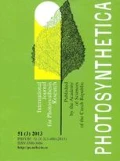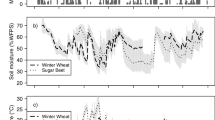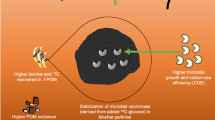Abstract
To investigate the effects of atmospheric CO2 enrichment on physiology and autumnal leaf phenology, we exposed 3-year-old sugar maple (Acer saccharum Marsh.) seedlings to 800 (A8), 600 (A6), and 400 μL(CO2) L–1 (AA) in nine continuous stirred tank reactor (CSTR) chambers during the growing season of 2014. Leaf abscission timing, abscised leaf area percentages, leaf number, light-saturated net photosynthetic rate (PNmax), leaf area, accumulative growth rates, and biomass were determined and assessed. The results suggested the following: (1) no significant differences were found in the timing of leaf abscission in the three CO2-concentration treatments; (2) PNmax was continuously stimulated to the greatest extent in A8 at 319% and 160% in A6 until the end of the growing season, respectively; and (3) leaf number, leaf area, and accumulative height growth all significantly increased by elevated CO2, which led to a 323% increase in A8 biomass and 235% in A6 biomass after 156-d fumigation. In summary, the results suggest, the timing of leaf abscission of sugar maple in fall was not modified by CO2 enrichment, the increased carbon gain by elevated CO2 was mainly due to increased leaf area, more leaves, and the continuously enhanced high photosynthesis throughout the growing season instead of the leaf life span.
Similar content being viewed by others
Abbreviations
- A4:
-
400 µL L–1 CO2
- A6:
-
600 µL L–1 CO2
- A8:
-
800 µL L–1 CO2
- CSTR:
-
continuous stirred tank reactor
- P Nmax :
-
leaf light-saturated net photosynthetic rate
References
Ainsworth E.A., Rogers A., Nelson R. et al.: Testing the “source–sink” hypothesis of down-regulation of photosynthesis in elevated CO2 in the field with single gene substitutions in Glycine max.–Agr. Forest Meteorol. 122: 85–94, 2004.
Albertine J.M., Manning W.J.: Elevated night soil temperatures result in earlier incidence and increased extent of foliar ozone injury to common bean (Phaseolus vulgaris L.).–Environ. Pollut. 157: 711–713, 2009.
Albertine J.M., Manning W.J., DaCosta M. et al.: Projected carbon dioxide to increase grass pollen and allergen exposure despite higher ozone levels.–PLoS ONE 9: e111712, 2014
Asshoff R., Zotz G., Körner C.: Growth and phenology of mature temperate forest trees in elevated CO2.–Glob. Change Biol. 12: 848–61, 2006.
Battipaglia G., Saurer M., Cherubini P. et al.: Elevated CO2 increases tree level intrinsic water use efficiency: insights from carbon and oxygen isotope analyses in tree rings across three forest FACE sites.–New Phytol. 197: 544–554, 2013.
Bazzaz F.A., Coleman J.S., Morse S.R.: Growth responses of seven major co-occurring tree species of the northeastern United States to elevated CO2.–Can. J. Forest Res. 20: 1479–84, 1990.
Borchert R., Robertson K., Schwartz M.D. et al.: Phenology of temperate trees in tropical climates.–Int. J. Biochem. 50: 57–65, 2005.
Cleland E.E., Chuine I., Menzel A. et al.: Shifting plant phenology in response to global change.–Trends Ecol. Evol. 22: 357–65, 2007.
Curtis P.S., Vogel C.S., Pregitzer K.S. et al.: Interacting effects of soil fertility and atmospheric CO2 on leaf area growth and carbon gain physiology in Populus× euramericana (Dode) Guinier.–New Phytol. 129: 253–263, 1995.
Elagöz V., Han S.S., Manning W.J.: Acquired changes in stomatal characteristics in response to ozone during plant growth and leaf development of bush beans (Phaseolus vulgaris L.) indicate phenotypic plasticity.–Environ. Pollut. 140: 395–405, 2006.
Ellsworth D.S., Liu X.: Photosynthesis and canopy nutrition of four sugar maple forests on acid soils in northern Vermont.–Can. J. Forest Res. 24: 2118–2127, 1994.
Ellsworth D.S., Thomas R., Crous K.Y. et al.: Elevated CO2 affects photosynthetic responses in canopy pine and subcanopy deciduous trees over 10 years: a synthesis from Duke FACE.–Glob. Change Biol. 18: 223–242, 2012.
Gaucher C., Gougeon S., Mauffette Y. et al.: Seasonal variation in biomass and carbohydrate partitioning of understory sugar maple (Acer saccharum) and yellow birch (Betula alleghaniensis) seedlings.–Tree Physiol. 25: 93–100, 2005.
Goulden M.L., Munger J.W., Fan S.M. et al.: Exchange of carbon dioxide by a deciduous forest: response to interannual climate variability.–Science 271: 1576–1578, 1996.
Gunderson C.A., Norby R.J., Wullschleger S.D.: Acclimation of photosynthesis and respiration to simulated climatic warming in northern and southern populations of Acer saccharum: laboratory and field evidence.–Tree Physiol. 20: 87–96, 2000.
Herrick J.D., Thomas R.B.: Leaf senescence and late-season net photosynthesis of sun and shade leaves of overstory sweetgum (Liquidambar styraciflua) grown in elevated and ambient carbon dioxide concentrations.–Tree Physiol. 23: 109–118, 2003.
Jach M.E., Ceulemans R.: Effects of elevated atmospheric CO2 on phenology, growth and crown structure of Scots pine (Pinus sylvestris) seedlings after two years of exposure in the field.–Tree Physiol. 19: 289–300, 1999.
Keenan T.F., Hollinger D.Y., Bohrer G. et al.: Increase in forest water-use efficiency as atmospheric carbon dioxide concentrations rise.–Nature 499: 324–327, 2013.
Kozlowski T.T., Kramer P.J. et al.: Physiology of woody plants.–In: Pallardy S.G. (ed.): Physiology of Woody Plants, 2nd ed. Pp. 454. Academic Press, New York 1997.
Körner C., Basler D.: Phenology under global warming.–Science 327: 1461–1462, 2010.
Li J.H., Dijkstra P., Hymus G.J. et al.: Leaf senescence of Quercus myrtifolia as affected by long-term CO2 enrichment in its native environment.–Glob. Change Biol. 6: 727–733, 2000.
Liu X., Ellsworth D.S., Tyree M.T.: Leaf nutrition and photosynthetic performance of sugar maple (Acer saccharum) in stands with contrasting health conditions.–Tree Physiol. 17: 169–178, 1997.
Manning W.J., Krupa S.V.: Experimental Methodology for Studying the Effects of Ozone on Crops and Trees. Surface Level Ozone Exposures and their Effects on Vegetation. Pp. 93–156. Lewis Publishers, Inc, Chelsea 1992
Menzel A., Sparks T.H., Estrella N. et al.: European phenological response to climate change matches the warming pattern.–Glob. Change Biol. 12: 1969–1976, 2006.
Norby R., Sholtis J., Gunderson C. et al.: Leaf dynamics of a deciduous forest canopy: no response to elevated CO2.–Oecologia 136: 574–584, 2003a.
Norby R.J., Hartz-Rubin J.S., Verbrugge M.J.: Phenological responses in maple to experimental atmospheric warming and CO2 enrichment.–Glob. Change Biol. 9: 1792–1801, 2003b.
Norby R.J., Warren J.M., Iversen C.M. et al.: CO2 enhancement of forest productivity constrained by limited nitrogen availability.–P. Natl. Acad. Sci. USA 107: 19368–19373, 2010.
Perttunen J., Nikinmaa E., Lechowicz M.J. et al.: Application of the functional-structural tree model LIGNUM to sugar maple saplings (Acer saccharum Marsh) growing in forest gaps.–Ann. Bot.-London 88: 471–481, 2001.
Redding E., Fernandez I., Day M. et al.: Phenology at the bear brook watershed in Maine, USA: foliar chemistry and morphology.–Am. J. Plant Sci. 4: 14, 2013.
Rogers A., Ellsworth D.S.: Photosynthetic acclimation of Pinus taeda (loblolly pine) to long-term growth in elevated CO2.–Plant Cell Environ. 25: 851–858, 2002.
Rosenzweig C., Karoly D., Vicarelli M. et al.: Attributing physical and biological impacts to anthropogenic climate change.–Nature 453: 353–357, 2008.
Schaberg P., van den Berg A., Murakami P. et al.: Factors influencing red expression in autumn foliage of sugar maple trees.–Tree Physiol. 23: 325–333, 2003.
Sigurdsson B.: Elevated CO2 and nutrient status modified leaf phenology and growth rhythm of young Populus trichocarpa trees in a 3-year field study.–Trees 15: 403–413, 2001.
Taylor G., Tallis M.J., Giardina C.P. et al.: Future atmospheric CO2 leads to delayed autumnal senescence.–Glob. Change Biol. 14: 264–275, 2008.
Telewski F.W., Strain B.R.: Densitometric and ring width analysis of 3-year-old Pinus taeda L. and Liquidambar styraciflua L. grown under three concentration of CO2 and two water regimes.–In: Jacoby G., Hornbeck J.W. (ed.): Proceedings of the International Symposium on Ecological Aspects of Tree Ring Analysis. Pp. 726–732. National Technical Information Service, Springfield 1987.
Wargo P.M.: Correlations of leaf area with length and width measurements of leaves of black oak, white oak, and sugar maple.–Forest Service Research Note, Northeastern Forest Experiment Station, 1978.
Warren J.M., Norby R.J., Wullschleger S.D.: Elevated CO2 enhances leaf senescence during extreme drought in a temperate forest.–Tree Physiol. 31: 117–130, 2011.
Zotz G., Pepin S., Körner C.: No down-regulation of leaf photosynthesis in mature forest trees after three years of exposure to elevated CO2.–Plant Biol. 7: 369–374, 2005.
Author information
Authors and Affiliations
Corresponding author
Additional information
Acknowledgements: We sincerely thank Professor Michelle DaCosta for kindly loaning of the LI-Cor 6400 photosynthesis system; we are grateful to Professor Robert Wick and Professor Lu Fei for their help with language and suggestions in experimental measurements. I am deeply appreciated the scholarship from The China Scholarship Council for supporting my study in USA.
Rights and permissions
About this article
Cite this article
Li, L., Manning, W.J. & Wang, X.K. Autumnal leaf abscission of sugar maple is not delayed by atmospheric CO2 enrichment. Photosynthetica 56, 1134–1139 (2018). https://doi.org/10.1007/s11099-018-0802-z
Received:
Accepted:
Published:
Issue Date:
DOI: https://doi.org/10.1007/s11099-018-0802-z




